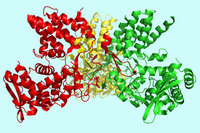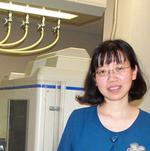Sometimes, even I get a little embarrassed (just a little) reporting week-after-week about the latest miracles coming from the Rice chemistry department.
The story reads that Jane Tao and a team that includes some UT people have unlocked the structure of the Influenza-A virus. Specifically, they have revealed the crystal structure of a molecule required for its reproduction. (All Influenza A has this structure, including the deadly bird flu and the epidemic 1918 flu.)
With the target protein’s crystalline structure revealed, scientists can now focus on designing a drug that will prevent it from reproducing.
There is a correction that should probably be made to the public record on this discovery. Actually, several.
First of all, Ms. Tao is in fact Yizhi Tao.
She got her B.S. in the Chinese capital of Beijing, and took her
doctorate from Purdue. (Go Boilermakers.) Also, she’s not a chemist,
but a biochemist. Her group’s home page features a picture of Einstein, with a thought balloon saying he needs a biochemist, along with this tao — from structure, dynamics to biology.
That is important because it basically explains her approach to the
subject. Define the chemical structure of something, understand the
dynamics of its reproduction, and you unlock the biology of the thing.
In this case the flu virus.
But what am I going to do with all these Kleenex’s?
Previous entries in what is becoming a series:
- Eugene Zubarev built gold nanostructures using a biological process.
- James Tour build nanotubes from seeds.
- Vicki Colvin showed how to remove arsenic from water using nano-rust.
- Lon Wilson attached drugs to nanotubes so they can target specific cells.
- Natasha Mehdiabadi showed how amoeba can distinguish family members from other amoeba (and decide to disrespect other amoeba).
More to come, I’m certain.












